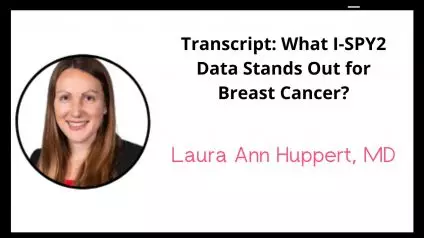
Transcript: So the I-SPY2Â trial is a neoadjuvant phase 2 study that enrolls patients with any type of breast cancer who have a tumor at least 2.5 centimeters in size and they’re randomized to receive the control which is neoadjuvant Paclitaxel followed by ac versus an investigational agent followed by AC and then the primary endpoint of the study is pathologic complete response rate or PCR and the in this study we basically wanted to look at there were a thousand patients that were the
📺 Click to Watch Video
🔊 Click for Audio Only
first thousand patients on the ice by two trial and we wanted to look at the patients that had hormone receptor-positive HER2 negative disease and look at the PCR rates by clinical and molecular featuresso specifically we were interested in the clinical features of stage and histology and the molecular features of whether they were mammoprint high one or high two so we took the mammoprint score in the lower end of the high score or the higher end of the high score and did that matter and we also looked at whether they were basal or luminal subtype and then also whether they had the response predictive subtype immune positive signature which I can describe a little bit more later and so in this study we found that patients that had stage two disease had higher rates of PCR than stage three which we might expect. Patients who had ductal histology had slightly higher rates than patients with lobular or mixed histology and I think the most interesting finding is that looking at the nema print and luminal basal distinctions looking at the molecular features so we found that patients who had mammoprint high one disease so the lower end of the high score had lower rates of PCR in the10 to 15 % range and across most of the treatment arms versus the higher end of the mammoprint the high 2 had mammoprint or had PCR rates in the 31 to 34 so significantly higher PCR rates if they were in the higher end of the mammoprint score and similarly patients who had the luminal subtype had lower rates of PCR versus those that had the basal subtype had much higher rates of PCR and then finally we looked at the response predictive subtype immune signature so my colleagues Christina Yao and Denise Wolf published a really elegant paper where they took different subtypes of breast cancer and further divided them by their molecular subtypes to create these response predictive subtypes that better predicted PCR than our classical hormonal receptor-positive HER2 negative triple negative subtypesand one of the subtypes they found in the hormone receptor-positive group was something called whether it was immune positive or negative and so when we looked at the patients in our cohort who are immune positive the rates of PCR were substantially higher than those who are immune negative particularly in the patients in the pembrolizumab arm the PCR rate was greater than 60 if they were immune positive versus only 4% if they are immune negative so I think the takeaways from the study is thatamong patients with hormone receptor-positive HER2 negative breast cancer it’s a very heterogeneous group and so some patients tend to respond better and some patients tend to respond worse and traditionally we’ve kind of grouped these patients all together and given them the same treatment but in fact I think there are very distinct subtypes there’s patients with higher risk disease lower risk disease that will respond better worse to neoadjuvant therapy and so by breaking these patients down by breaking them down by the different molecular pattern we can really better predict who’s going to respond and ideally in the future tailor their treatment to based on these response predictive subtypes and molecular features
Question – Will This Affect Clinicians Today?
So I think in terms of whether this data will affect clinicians today, at this point it’s relatively hypothesis generating so I don’t think it’s going to change treatment tomorrow per se but I do think that the concepts are potentially going to change the way we practice treatment of breast cancer in the future because I do think that if we can better distinguish subtypes of breast cancer by these molecular features we’ll be able to better treat patients by pairing you know their breast cancer biology with the best treatment and so really have a more biologically based and individualized treatment approach and one of the really interesting things we’re doing in the eye spy 2 study is we’re actually this month rolling out I-SPY2.2 which rather than just randomizing patients based on whether they’re er positive HER2-positive triple negative we’re using these response predictive subtypesto betterto to randomize patients basically based on the biology of their disease and that’ll help hopefully it’ll better predict PCR rates so we’re going to put the the work from this study and several others in the I-SPY2 group into action and prospectively look at it in the I-SPY2.2 study
Question – Final Thoughts
I think in closing the most exciting aspects of this data are that we are better able to break down hormone receptor-positive HER2 negative breast cancer into these distinct subtypes that respond better or worse to neoadjuvant therapy and I think we need to study this more and understand which patients will benefit most from neoadjuvant treatment because hopefully, we can better classify hormone receptor-positive HER2 negative breast cancer to individualize treatment for these patients based on biology to improve outcomes for this really heterogeneous group of patients.

